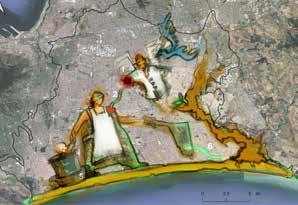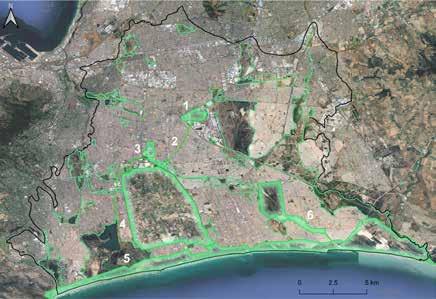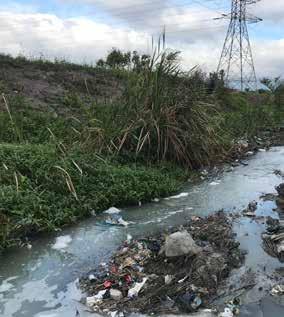
7 minute read
Water architects of our own destiny
from IMIESA July 2020
by 3S Media
In striving for a better world driven by innovation, engineers and scientists often neglect the human side of the equation. That has the potential to derail the best infrastructure initiatives. Rowena Hay, managing director, Umvoto Africa, shares her thoughts and experiences with reference to the company’s Cape Flats Aquifer (CFA) and allied projects.
Within the developing world, poverty is an endemic issue that erodes hope and
Advertisement
By Alastair Currie
fragments communities, often with destructive results. South Africa is no exception, but the challenges become even more complex here because of our pre- and post-1994 experience.
“Poorer communities tend to feel marginalised – that the solutions scientists and engineers deliver are prescriptive rather than participative,” says Hay. “This marginalisation makes it much more difficult to get buy-in if life is a day-to-day fight for survival. This observation has been highlighted time and again during our hydrogeology work for the City of Cape Town (CoCT), and particularly on the CFA project.”
Identified as a major groundwater source in the 1970s, the CFA was only intermittently explored and monitored over the ensuing decades. That changed in 2018 when Cape Town initiated its Day Zero emergency programme in response to an unprecedented
Taking a fresh perspective, Anni Snyman, a passionate land artist, presented a unique way to reimagine the Cape Flats Aquifer. The GIS grid lines suggested various imaginary forms, incorporating the central figure of a woman holding a ladle ready to dip into the waters of False Bay

drought. Verifying and preserving groundwater resources became a priority, and with it the need to manage environmental impacts and consumption behaviour.
Umvoto’s project scope for the CFA began in 2017 when the company was appointed by the CoCT to investigate the development of the aquifer as an emergency storage resource. An allied project entailed the upgrading and refurbishment of the Atlantis well field as well as paced development of the Table Mountain Group Aquifer. All are ongoing.
The CFA project includes detailed mapping of the aquifer’s extent and properties, the establishment and maintenance of a monitoring programme, plus the design and implementation of a scheme that includes both managed aquifer recharge and abstraction. Atlantis, in turn, has been restored to full operation and is being monitored and managed along similar lines.
Extending below the city’s low-lying eastern suburbs, formal and informal townships, the CFA is fed by stormwater inflows that have occurred for many decades. As with
GIS mapping of six key zones within the Cape Flats Aquifer system. This initiated a discussion on aquifer protection zones, which have been further detailed according to contaminant transport pathways, life expectancy of contaminants and their characteristics, as well as likely resident times. This and the subsequent art rendered graphic can be used to illustrate the complex space and time relationships between human activities and groundwater flow regime and quality in a visually accessible and digestible manner for the layman. Insight inspires positive behaviours and possibility
most cities worldwide, some natural streams have been channelled to make way for urban development, generally as stormwater drains, treated wastewater outflows or irrigation canals – all of which influence the downstream quality and quantity of the groundwater.
Great Lotus Canal
Within the CFA region, the Great Lotus Canal (GLC) is a dominant arterial. It was originally designed to channel stormwater from the
ABOUT UMVOTO AFRICA

Established in 1992, Umvoto Africa is internationally recognised and has one of the largest groundwater specialty teams in Southern Africa. The company also operates within the fields of integrated water resource management, disaster risk reduction (DRR), geo-risk assessment and prevention, geoinformatics, and remote sensing.
site of today’s Cape Town International Airport, developed in the 1950s. Today, the GLC flows through formal and informal settlements. Formal settlements include Nyanga and Gugulethu.
Urbanisation and rapidly intensifying human settlement invariably result in an increasing demand on the overall potable water available for consumption. Unfortunately, there’s frequently a corresponding rise in pollution levels, especially when it comes to informal communities. This has had negative downstream impacts for the GLC in terms of plastic and allied litter, and faecal waste.
Given the GLC zone’s strategic contribution to the water cycle, it was identified for urgent intervention. The goal is to restore a healthy surface-water environment and protect a substantial sector of the underlying CFA from toxic pollutants of industrial and domestic origin. To achieve this requires ongoing community liaison and education.
Outreach challenge
Umvoto’s early experimentation with community engagement began in 2002 during a groundwater project in Hermanus, Western Cape. “At the time, we felt that the environmental impact assessment process was too focused on a regulatory ‘tick box’ approach. It did not factor in human beings,” says Hay.
A graphic from The Water Catcher animated film funded by Umvoto Africa as part of its transformative art outreach programme on the Cape Flats

“On our own initiative, we started an environmental monitoring group, which was very successful. Rather than confrontation, we achieved participation. We gave the community the knowledge to say yes, rather than the uninformed power to say no,” she continues. “Today, a monitoring committee is a standard requirement for water-use licence applications, but it wasn’t then.”
While a similar methodology was needed, the extreme poverty and crime prevalent across the Cape Flats called for a different approach, which Umvoto coined the Great Lotus Canal Challenge. “If you change the conversation, you open up new worlds of possibility, and to achieve this we made transformative art the core of our outreach initiative,” says Hay.
Transformative art
South African artist Anni Snyman, from Site_Specific Collective, is Umvoto’s instrumental partner in changing hearts and minds. A land art specialist, Snyman encapsulates the end goal perfectly, “We can’t live without water, and we can’t thrive without beauty.”
Umvoto Africa has mapped out six Collaborative Zones within the CFA footprint for the rollout of its community outreach programmes, working with Site_Specific Collective and allied partners. The Great Lotus Canal Challenge is the first in a series of transformative art projects planned across the Cape Flats. It inspired the creation of an animated short film entitled The Water Catcher.
Adds Hay: “Art is a great equaliser – a medium of expression unconstrained by so-called expert knowledge. And if you truly want to effect permanent behaviour change, you need to capture people’s imagination and empower them with knowledge. If you can see a vision of yourself in the future, it builds optimism and hope.
“From our collective teachings, that translates into an understanding and appreciation of the full water cycle, rather than just the scientific or infrastructure elements. The vandalism we’ve seen at certain borehole installations is a prime example of a knowledge disconnect – of hope that has been eroded,” she expands.
The other Great Lotus Canal Challenge partners were Communitree, an organisation that specialises in urban greening to support local biodiversity and community empowerment, and the Edith Stephens Wetland Park. The challenge entailed the clean-up of a section of the canal, fence art to create public awareness and community pride, environmental stewardship training, and plant-growing workshops.
Umvoto covered the cost of the one-week stewardship course, which teaches community

The encroachment of informal settlements has exacerbated the chronic challenge of plastic and other solid pollution as well as untreated human waste, turning parts of the Great Lotus Canal – which was designed as a stormwater system – into an open sewer, even when there has been no rainfall
members about water, hydrology, biodiversity and conservation. The course was successful and Umvoto believes that similar programmes should become standard for public-sectorfunded projects.
Working with its strategic partners, Umvoto plans to start on the next phase of its CFA transformational art and environmental stewardship initiatives as soon as new funding becomes available.
Lessons from Day Zero
In the end, the rains came and fortunately Day Zero didn’t happen. What did happen was a remarkable change in water use behaviour and a real appreciation for this finite resource. The hard interventions only worked because of the ‘soft’ ones, particularly the community engagement forums. Within Umvoto’s specialist field, it is called social hydrogeology.
In the past two and a half years, Umvoto’s contracting teams have drilled over 200 boreholes on the Cape Flats. The imminent threat of Day Zero back in 2017 meant that development and exploration had to take place simultaneously.
“Things have stabilised since then, but Day Zero has taught us the dangers of complacency and the need for conservation. It has also exposed the stark realities of communities left without a sense of purpose or direction. We can only win if we work together as a society,” Hay concludes.










